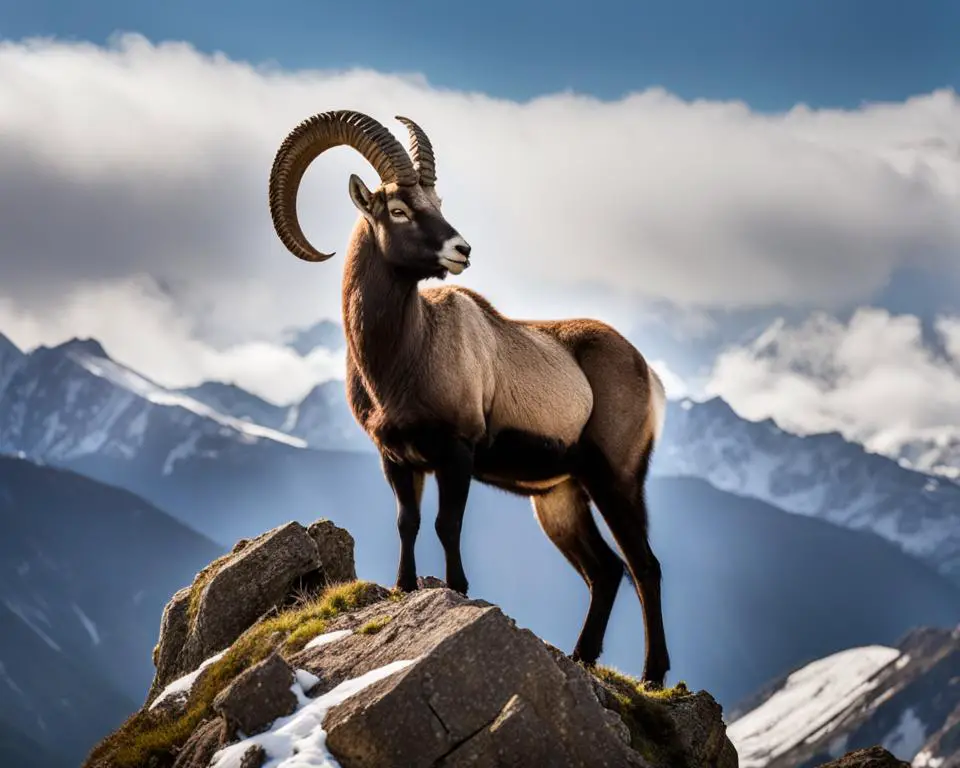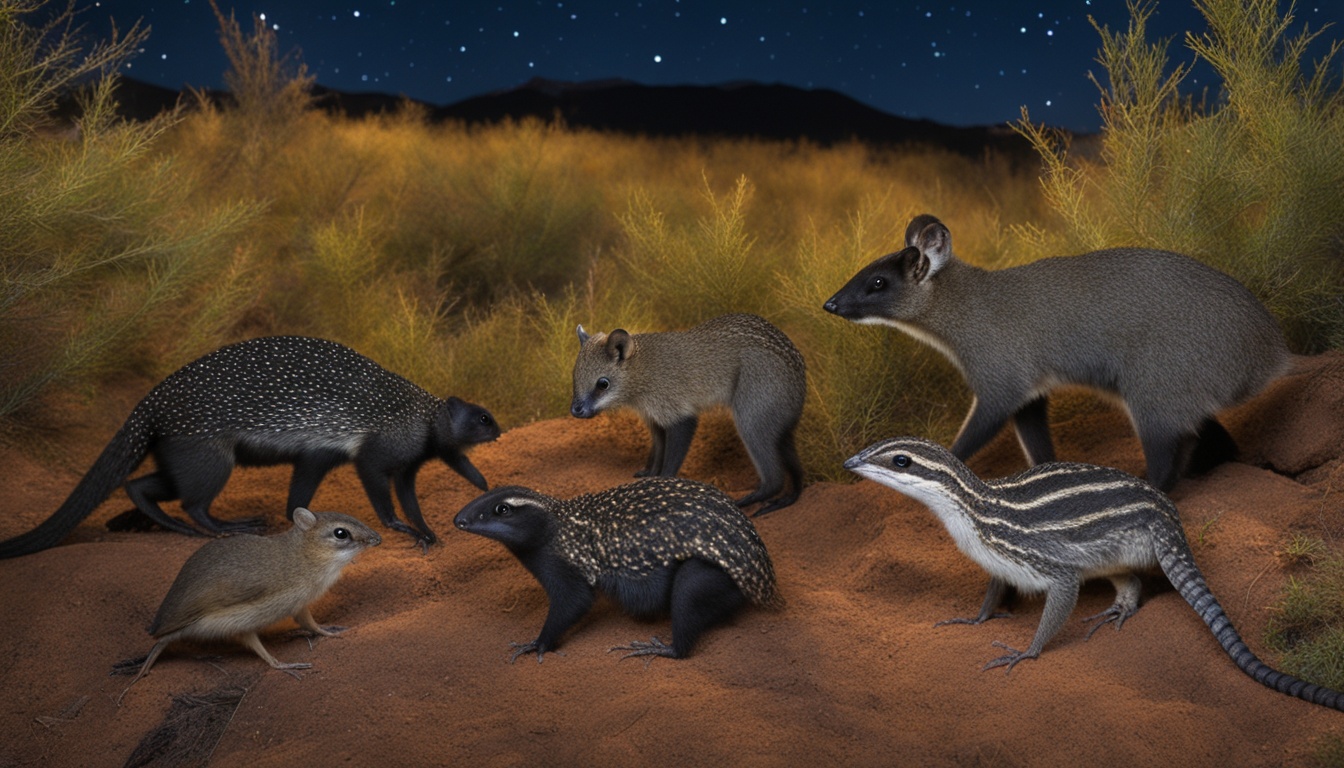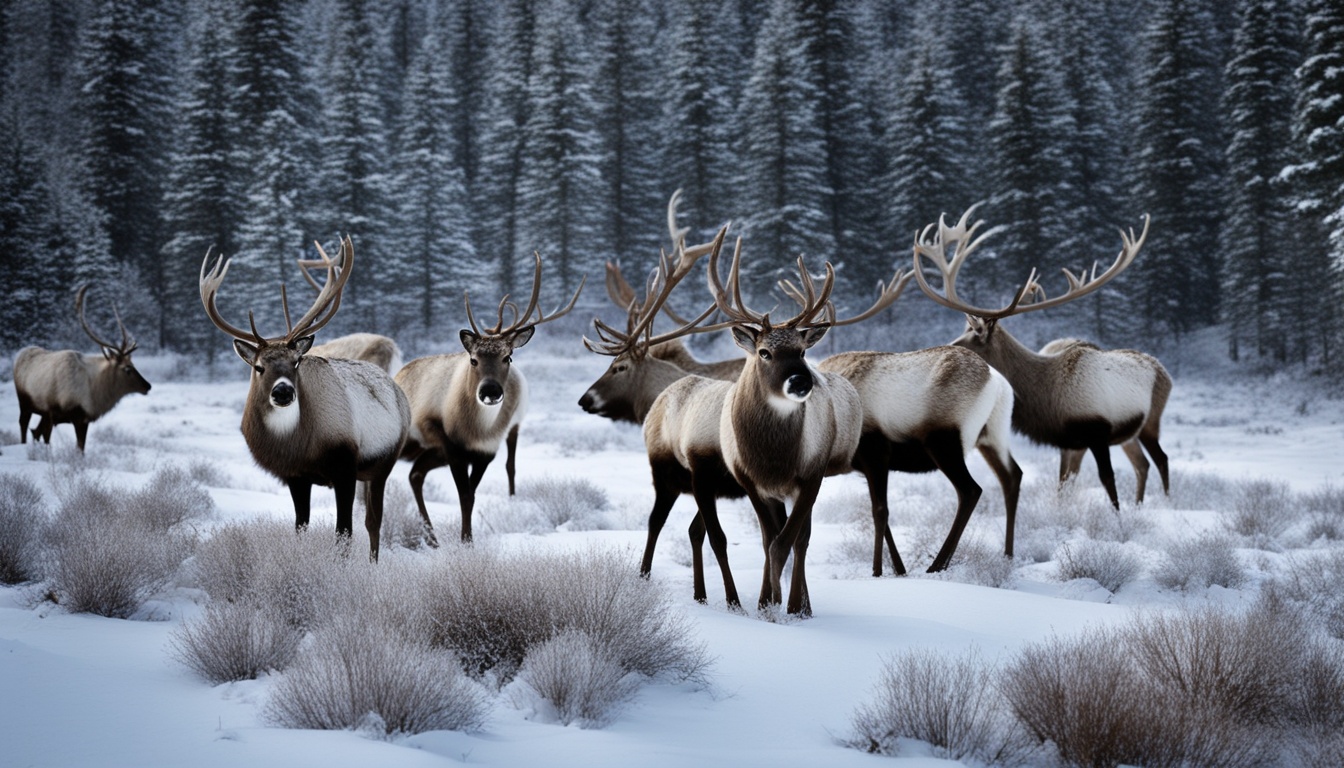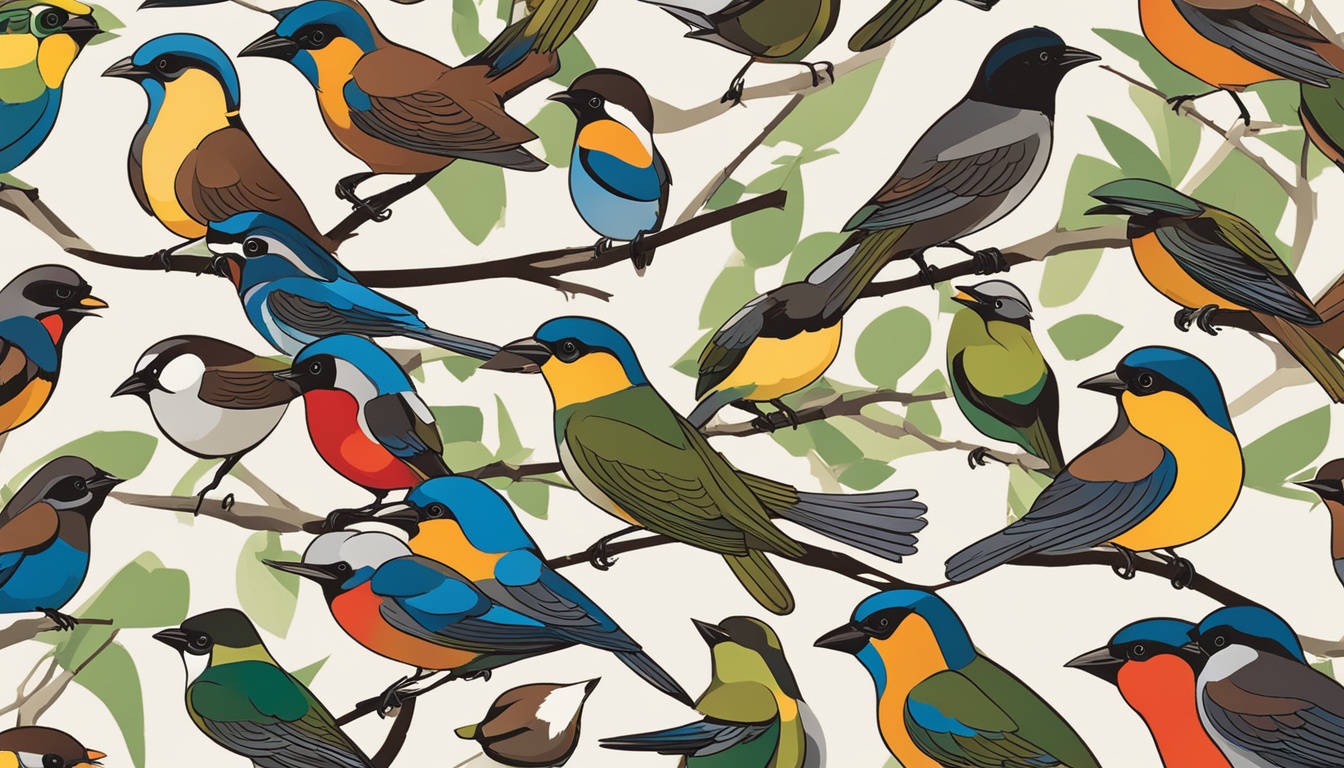Imagine standing face-to-face with one of nature’s most majestic creatures, whose ability to scale daunting cliffs challenges gravity itself. You’ve just pictured the ibex, an awe-inspiring species of mountain goats that call some of the world’s most precipitous terrains their home. With their unique adaptations, these wild animals are archetypes of survival, gracefully bounding across vertiginous landscapes where few dare tread. Join us as we unveil wild ibex facts, shedding light on the lives of these elusive highlanders. Explore a world where agility and strength have shaped one of the most remarkable inhabitants of the mountainous regions of Europe, north central Asia, and northern Africa.
As your guide to understanding the ibex, we will leap into the heart of their habitats, embarking on a journey to uncover the secrets of their survival. Ready yourself to traverse rocky ridges and sheer cliff faces in the company of these majestic creatures, whose fortitude and finesse shimmer as beacons of the wild.
The Majestic Mountain Dwellers: Understanding Ibexes
Perched in the world’s most precipitous landscapes, the species of Ibex are striking symbols of resilience and elegance. These creatures, though seemingly from a realm of fantasy, are firmly grounded in reality, showcasing a fascinating evolutionary journey that you will find both enlightening and inspiring.
Distinguished relatives of antelopes and buffalos, ibexes boast not only tenacity but a shared genealogy with other respected animals in the Artiodactyla order. Did you know that the anatomy of ibex is a triumph of nature’s design, equipping them perfectly for their vertical world?
The Shared Genealogy of Ibexes and Other Hoofed Animals
It’s not just the rugged cliffs that connect these majestic mountain dwellers to one another, but a lineage that links them to cattle, goats, sheep, and even bison. While the diversity in sizes and habitats among the species of ibex is mesmerizing, their genetic connections underscore a fascinating evolutionary pathway.
Anatomy of Supreme Adaptation: Horns and Hooves
Your adventure through understanding ibexes takes you to the anatomy that serves as their survival toolkit. With horns that can span up to 5 feet and curve gracefully backward in a semicircle, bedecked with knobby rings, male ibexes wear crowns that signal their prowess and strength.
Imagine the thrill of witnessing an ibex scaling steep cliffs, as if defying gravity, thanks to their specialized hooves. Designed with concave undersides, these hooves grasp the rock like nature’s suction cups, mastering the craggy terrain. This anatomy truly is the stamp of extreme adaptation.
Societal Structures: From Bachelor Herds to Matriarchal Groups
Unraveling the social behavior of ibexes reveals a structured society almost as layered as the mountains they inhabit. Bachelor herds are the norm for males, who lead a largely solitary existence or roam with other males, only mingling with females when nature calls for reproduction.
Female ibexes, on the other hand, lead their offspring in tight-knit groups. These matriarchal groups weave the fabric of the next generation, nurturing and teaching them the ways of the mountain. Observing how these herds interact provides a unique glimpse into the complex social behavior in ibexes.
Anatomical Marvels: Here’s a closer look at the extraordinary physical features of these incredible climbers.
| Feature | Description | Function |
|---|---|---|
| Horns | Long, curved, with outer knobby rings | Used for defense and mating displays |
| Hooves | Sharp edges with concave undersides | Offer a superior grip on rocky terrains |
| Beard | Typically seen in males | Used in scent communication during breeding |
| Coat | Coloration varies; some with shiny coats that reflect sunlight | Adapted for climate; aids in temperature regulation |
So, as we delve deeper into the lives of these fascinating creatures, remember that the ibex is more than just a mountain dweller. They are the embodiment of adaptation, a living testament to the ingenuity of evolution, conquered through the anatomy of ibex and their inherent social intelligence.
Ibex Habitats: Cliffs, Altitudes, and Survival
As we venture into the terrain of the ibex, it becomes clear why these cliff-dwelling mammals are considered true survivors. Their habitats are as varied as their species, each adapted to environments that push the limits of the natural world. From the dizzying altitudinal range of the Ethiopian highlands, where the Walia ibex reigns supreme, to the scorching cliffs where the Nubian ibex displays heat adaptation at its finest, every aspect of their living space has been carved by the necessity of survival.
Variations in Habitat Among Ibex Species
The ibex habitat varies significantly across species, demonstrating a splendid versatility and resilience. In the lofty heights where air thins, the cliff-dwelling Walia ibex withstands the thin atmosphere, whereas its cousin, the Nubian ibex, has mastered survival in the blistering heat of African and Arabian mountains. Their respective habitats are testaments to the incredible diversity within the genus Capra, each with their unique adaptations to the extremes of earth’s varied topographies.
Masterful Climbers: The Ibex’s Home in the Clouds
With an incredible altitudinal range, some species of ibex navigate near-vertical surfaces to perch in their high-altitude sanctuaries. Not only are they dexterous in their movements, but they show a finesse in their choice of habitat, selecting the most inaccessible cliffs as refuges from predators. Their agility is awe-inspiring; watching an ibex leap and scale precipitous walls is like witnessing the fine art of survival choreographed on nature’s grand stage.
The Role of Coat and Coloration in Heat Regulation
An ibex’s coat is not just for show—it’s a vital tool for heat adaptation. The Nubian ibex’s shiny coat, for example, is more than just visually striking; it reflects sunlight to keep these animals cool under the relentless heat. This ingenious adaptation allows them to endure temperatures that would prove intolerable to many other species, all the while maintaining the stamina to traverse rugged landscapes in search of food and water.
Delving deeper into the environmental tenacity of these incredible animals reveals a story of evolution’s brilliance. Let’s examine some key adaptations that detail how ibexes flourish in the extreme conditions they call home.
| Adaptation | Species | Habitat | Survival Benefit |
|---|---|---|---|
| High-altitude living | Walia ibex | Ethiopian highlands | Protection from predators |
| Sunlight-reflective coat | Nubian ibex | African/Arabian mountains | Heat regulation |
| Exceptional climbing ability | Alpine ibex | Italian Alps | Access to mineral licks on steep cliffs |
| Specialized hoof structure | Multiple species | Rocky terrains across ranges | Enhanced grip for climbing and stability |
Ibexes continue to amaze and inspire with their unparalleled ability to conquer worlds on the edge—quite literally. As signature dwellers of cliff sides and masters of high-altitude survival, they embody nature’s capacity for extraordinary adaptation in the face of environmental challenges.
The Diet of Ibexes: Herbivores on the Hillsides
When you gaze upon the rugged terrains where ibexes thrive, it’s not just the raw beauty of nature that captivates you but also the remarkable herbivorous behavior of these agile climbers. Ibexes, thriving on a stark vegetation diet, are consummate grazers, artfully navigating their steep, rocky homes to find sustenance. Their grazing habits, a testament to their adaptability, show an enviable patience and persistence in finding their daily meals amidst sparse flora.
Through a fine-tuned balance between energy exerted and energy gained, ibexes have carved a niche in their unforgiving habitat. It is not an easy task to subsist on low-nutrient plants, yet these animals spend a significant portion of their day partaking in this very activity. Let’s take a closer look at the components of an ibex diet that sustain these resilient herbivores on the hillsides.
- **Shrubs:** Tough and resilient, like the ibex themselves, shrubs provide a reliable source of food that endures seasonal changes in weather.
- **Bushes:** Offering both leaves and stems, bushes contribute to the varied diet that keeps ibex populations healthy.
- **Grasses:** A staple in the ibex menu, the grazing of grasses plays a critical part in their daily eating pattern, requiring hours of feeding to meet their nutritional requirements.
- **Trees:** When meadows are sparse, ibexes are known to stand on their hind legs, stretching their lithe bodies to reach the tender leaves and twigs that trees offer as a precious meal or snack.
| Food Source | Benefits to Ibex | Common Habitats |
|---|---|---|
| Shrubs | Diverse nutrients, year-round availability | Rocky slopes and cliffs |
| Bushes | Rich in fiber, provides energy | Mediterranean woodlands and scrublands |
| Grasses | Easily digestible, abundant in spring and summer | Grassy meadows at high elevations |
| Trees | Seasonal variability, higher calorie content | Forest edges and subalpine zones |
It’s fascinating, the lengths to which these creatures will go to sustain themselves. They balance their day with intensive feeding sessions and rest periods on their favorite sunbathed ledges. Now picture a magnificent ibex, poised on a high ridge, surveying the valleys below not merely for the view, but for its next meal. This is the life of an ibex—always on the move, always in search of the next patch of green. Every blade of grass, every leaf, becomes a precious commodity in the life-sustaining economy of the highlander.
With their reliance on plants for nutrition, ibexes are a shining example of herbivorous behavior in the wild. Their dietary habits offer us a window into their world—a world where the balance of survival is as delicate as the vegetation that clings to the mountain’s edge. As you reflect on the ibex diet, consider how each nibble of grass and every stripped twig is a small victory against the elements, a testament to the tenacity of these horned herbivores of the hillsides.
Reproduction and Life Cycle: The Journey from Kid to Adult
The raw beauty of nature is nowhere more apparent than in the Ibex reproduction rituals. Here, in the wild theater of the mountains, males engage in a dramatic dance of dominance for the right to mate, culminating in intense head clashes. This period, known as the rut, is when the ibex’s life cycle commences anew. You can almost sense the tension in the air as the ritual unfolds against the backdrop of the rugged terrain.
It’s the females, however, who carry the future of the species. After a gestation period ranging from 147 to 180 days, an ibex doe retreats to find a secluded spot for the birthing process. Here, in privacy, she gives life to her offspring—usually one to three Ibex offspring, called kids. These newborns are not only a wonder to behold but also present an astonishing display of agility from the moment of birth.
Just picture it: within moments of entering this world, an ibex kid is already on its feet, defying the steep slopes with a natural grace. By the tender age of four weeks, these kids are integrated into the herd, by which point they can be seen bounding alongside their kin with youthful abandon. Motherhood in the ibex world is as nurturing as it is in any corner of nature, with mothers weaning their young by six months and guiding them through at least the first year of life.
Set against the lifespan of these rugged denizens, clocking in at around 17 years in the wild, the window for females to reproduce—spanning from ages 2 to 6—seems fleetingly brief. Yet it is during these years that the continuation of the ibex lineage is ensured.
| Reproductive Stage | Duration | Behavioral Characteristics |
|---|---|---|
| Gestation Period | 147 to 180 days | Female isolation for birthing |
| Birth | Immediate activity | Newborn agility and herd integration |
| Weaning Period | Up to 6 months | Dependency on mother’s milk then gradual shift to vegetation |
| Post-weaning | Up to 1 year | Extended protection and guidance from mother |
| Reproductive Maturity | 2 to 6 years of age | Females begin birthing their own young |
So when you next marvel at these extraordinary creatures, remember the miraculous cycle that ushers them from their first breath to their eventual rise as the new guardians of the crags. It’s a cycle not only crucial to their survival but one that enriches the natural world with each kid’s first intrepid steps.
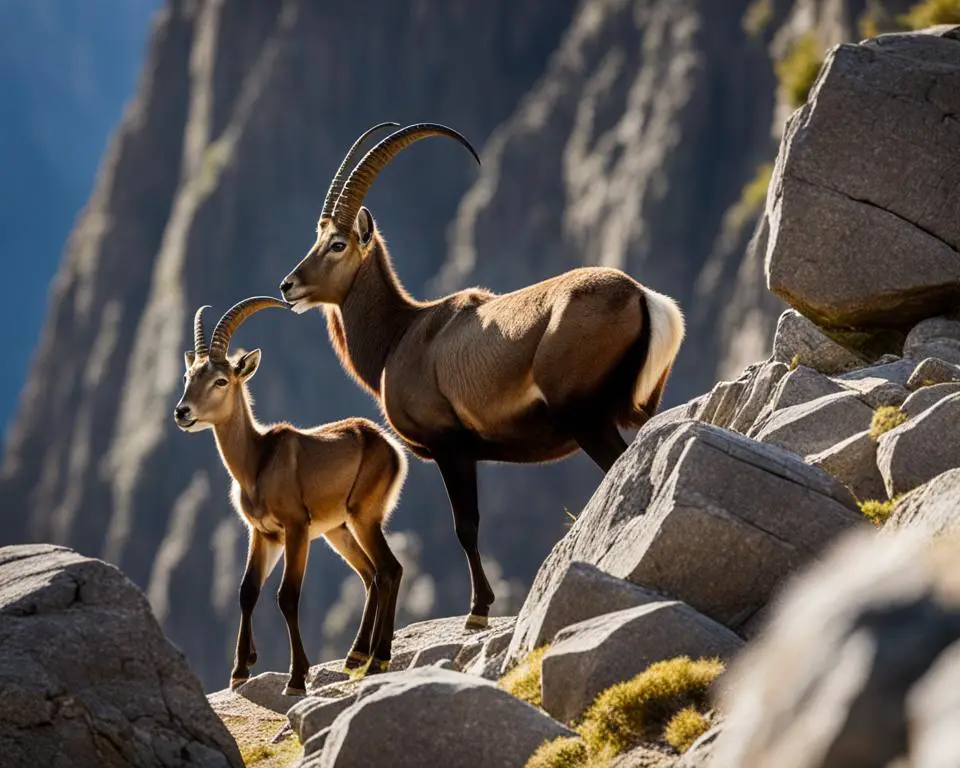
Classification and Taxonomy of Ibexes
As you venture deeper into the world of ibexes, it’s essential to understand their place within the animal kingdom. The precise categorization of these animals is key to appreciating their unique traits and the relationships they share with other species. The Ibex taxonomy branches out into several distinct classifications, underscoring their fascinating biological heritage within the Capra genus and the wider Bovidae family.
Let’s dissect the taxonomy levels that detail where ibexes stand amidst the broader spectrum of life forms:
- Kingdom: Animalia – Recognizing ibexes as complex, multicellular organisms that are highly active and mobile.
- Phylum: Chordata – Characterized by having a spinal cord, ibexes are part of this distinguished group of animals.
- Class: Mammalia – As mammals, ibexes nourish their young with milk and boast warm-blooded flexibility in extreme temperatures.
- Order: Artiodactyla – Known as even-toed ungulates, members of this order, including ibexes, bear their weight across two of the toes on each foot.
- Family: Bovidae – Encompassing a range of hoofed mammals, the Bovidae family groups ibexes with antelopes, gazelles, and cattle, highlighting their shared traits and lineages.
- Genus: Capra – A genus within the Bovidae family, Capra defines true goats and related species.
In the grand assembly of life forms, ibexes hold their ranks with dignity, forming part of an intricate web that ties them to a variety of closely and distantly related creatures. The following table outlines the recognized ibex species within the Capra genus, presenting you a clearer picture of these astounding animals:
| Common Name | Scientific Name | Notable Traits |
|---|---|---|
| Alpine Ibex | Capra ibex | Native to the European Alps, known for formidable horn size and agility. |
| Nubian Ibex | Capra nubiana | Adapted to arid mountainous regions in Africa, with a dust-reflective coat. |
| Spanish Ibex | Capra pyrenaica | Indigenous to the Iberian Peninsula, varied in size and coloration. |
| Siberian Ibex | Capra sibirica | Inhabits various parts of central Asia, with robust build and survival prowess. |
| Walia Ibex | Capra walie | Endemic to the high cliffs of the Ethiopian highlands, critically endangered. |
The allure of the ibex goes beyond its adaptive capabilities and into the realm of taxonomy. Every species of ibex adds another layer to the rich tapestry that is the Capra genus within the Bovidae family, anchoring their presence in the natural world with unique distinctions and shared attributes. Now that you’re armed with this knowledge, you can appreciate these mountain monarchs with a new depth of understanding.
The Challenging Conservation Status of Ibex Species
The awe-inspiring ibex, with its spiraling horns and agile leaps, stands at a crossroads of survival in the wild. While the ibex’s ability to conquer steep mountain terrains is renowned, several factors including habitat destruction and hunting have pushed some species to the brink of extinction. Understanding the conservation status of Ibex, particularly the endangered species like the Nubian and Walia ibexes, sheds light on the pressing need for conservation efforts tailored to ensure Ibex population recovery.
The Decline of the Nubian and Walia Ibexes
Although many species of wild goats continue to thrive across the globe, the story is different for the Nubian ibex and, more critically, for the Walia ibex. Habitat encroachment, climate change, and persistent hunting pressures have resulted in a significant reduction in their numbers. The International Union for Conservation of Nature (IUCN) classifies the Nubian ibex as vulnerable, highlighting a concerning decline in mature individuals. Meanwhile, the Walia ibex faces an even more precarious future, being categorized as endangered with only an estimated 500 individuals left.
Conservation Efforts and the Hope for Recovery
Amidst these challenges, hope endures through concerted conservation efforts aimed at reversing the decline of these majestic creatures. The creation of national parks and protective legislation has afforded some reprieve, while carefully managed reintroduction programs seek to bolster wild populations. Advancements in conservation technologies and strategies augment these initiatives, promoting habitat restoration and creating safer environments for these animals to flourish.
Cloning Endeavors: The Science of Bringing Back the Lost
In a groundbreaking development, the extinct Pyrenean ibex was briefly brought back through the marvel of cloning in 2009. Although the clone survived only for minutes, this milestone in science represents a glimmer of hope for cloning extinct animals and awakening the possibility of resurrecting species that we’ve tragically lost. The implications of such scientific endeavors could be profound, potentially aiding in the recovery and stabilization of endangered ibex populations around the world.
The plight of the ibex teaches us valuable lessons about our impact on the natural world and the resiliency of life. Through understanding their challenges and championing their cause, we stand a chance to witness the return of these incredible animals from the brink of disappearance, ensuring that future generations may be inspired by the iconic silhouette of the ibex against the mountain sky.
The Unique Physical Abilities of Ibexes
As you marvel at the sheer agility in Ibex populations, you can’t help but be impressed by their remarkable jumping capabilities. Agile climbers by nature, ibexes possess physical adaptations that are nothing short of extraordinary. Their ability to leap more than 6 feet vertically from a standstill ensures that even the steepest mountain slopes are within their realm. The secret to their impressive acrobatics lies not only in their muscular legs but also in their evolutionarily honed hooves and horns.
Physical adaptations, such as the unique structure of their hooves, are central to the ibex’s climbing prowess. These specialized hooves are equipped with sharp edges and concave bottoms, allowing for incredible grip on almost vertical surfaces, turning dauntingly slick cliffs into playgrounds. Such adaptations have elevated the ibex to be one of the most competent climbers in the animal kingdom. It’s a survival trait that allows them to access food sources in seemingly inaccessible places and evade predators with ease.
As for their horns, they are not just for show; they serve vital roles in both defense and social interactions, particularly during the mating season when males display their vitality and vigor. The robust nature of their horns, which grow continuously throughout their life, acts as a symbol of age and dominance, playing a crucial part in the ibex’s social hierarchy. The natural weaponry of ibexes is awe-inspiring – both a tool for survival and a marker of status.
If you’re fortunate enough to observe these creatures in their natural habitat, you may witness the ibex in motion, showcasing a symphony of strength and agility. It’s a breathtaking sight, reminiscent of the grace of a ballet dancer and the power of a linebacker, all rolled into one astonishing display of nature’s grand design.
The table below highlights some of the specific physical attributes that contribute to the ibex’s ability to master their mountainous environments:
| Physical Feature | Adaptation Details | Contributions to Agility |
|---|---|---|
| Horns | Large, robust, and curved | Used for defense and as tools during foraging |
| Hooves | Sharp perimeter edges with concave undersides | Allows secure footing on narrow ledges and steep inclines |
| Leg Musculature | Powerful hindquarters capable of explosive force | Enables high jumps and quick changes in direction |
| Balance | Low center of gravity and a flexible spine | Facilitates nimble movements and stability on uneven surfaces |
While these traits are representative of the ibex’s physical prowess, it’s their excellent use of these adaptations that underlies the agility that leaves onlookers astounded. As with other wonders of nature, witnessing an ibex negotiate the verticality of its home is to watch evolution perfected – an example of what it takes to thrive against the raw backdrops they inhabit. Remember, these creatures are more than capable of showing off feats of their extraordinary agility – a harmony of form, function, and survival strategy in motion.
People and Ibexes: Historical Hunting and Domestication
Delving into the annals of history, the ibex-human relationship is carved from tales of survival and symbiosis. Humans have long looked upon the majestic ibex not only with wonder but also as essential contributors to their sustenance and economy. From the steep cliffs these creatures effortlessly navigate to the early human settlements below, the paths of ibexes and people have intertwined for countless generations.
The Evolution of Human-Ibex Relations
Your bond with these agile mountain goats may be closer than you realize. Historical hunting practices have demonstrated that humans relied on ibexes for their meat and coveted hide. Such was the dependency that it sparked a need for proficiency in the hunt, heralding a relationship grounded in respect and the relentless challenges of highland stalking. These practices paved the way for nuanced understanding and eventual efforts to domesticate their docile cousins.
Domestication: From Wild Goats to Farmyard Animals
It’s fascinating to think that the domesticated goats you may see on a farm share an ancestral lineage with the wild ibexes of yore. The domestication of goats, a pivotal chapter in human advancement, began around 8,000 to 10,000 years ago in Southwest Asia and the Middle East. This initiative represented an evolutionary leap for both species, with humans breeding and nurturing these vital sources of food, clothing, and materials for their growing civilizations.
| Period | Human-Ibex Interaction | Impact on Human Culture |
|---|---|---|
| Ancient Times | Hunting for sustenance | High reliance on ibex resources |
| 8,000-10,000 years ago | Domestication begins | Development of agricultural practices and sedentary lifestyles |
| Modern Day | Conservation and appreciation | Recognition of biodiversity and natural heritage |
The compelling saga of ibexes and humans is a potent reminder of your connection to the natural world. It highlights a story of cooperation and innovation, with the domestication of goats stemming from these storied mountain climbers and becoming essential to human prosperity. Even today, you can’t help but be moved by the ongoing narrative of these resilient creatures and their place alongside humanity.
Fun Facts About Ibexes: The Amazing Acrobatics of Mountain Goats
As you venture into the realm of mountain wildlife, ibexes are sure to captivate your attention with their jaw-dropping acrobatics and nimble movements. These remarkable animals exhibit mountain goat behavior that echoes centuries of evolutionary mastery, complementing their unyielding terrain with a show of agility that is near supernatural.
Renowned for their rock-climbing prowess, ibexes, specifically the Alpine ibex, can astound you with their ability to navigate and dominate seemingly vertical planes. Witnessing their acrobatic feats, you’d find yourself intrigued by ibex facts—how they effortlessly leap and scale draped cliffs in search of nutrients, embodying adaptability and dexterity unlike any other creature.
Their survival in rugged environments is not solely a testament to their tenacity but also to the unique physiological adaptations they possess. These ibex acrobatics showcase a blend of strength, precision, and balance, thus making ibexes a fascinating study of mountain goat behavior in its purest form.
If you happen upon these agile mountaineers, you’ll notice they convey confidence, each hoof-fall an assertion of vitality upon the precipice. Their every jump and pivot is a dance with gravity, offering you a breathtaking glimpse into the lives of creatures shaped by their formidable habitats.
| Ibex Attribute | Description | Role in Acrobatics |
|---|---|---|
| Horns | Long and curved with knobby rings | Used for balance and as leverage in climbs |
| Hooves | Concave undersides with sharp edges | Provide grip and precision on steep rocks |
| Agility | Ability to leap 6 feet upwards without a run-up | Access inaccessible areas and escape predators |
| Strength | Powerful leg muscles | Support their weight and enable high jumps |
It’s the mergence of innate tendencies and environmental necessity that shapes the course of their existence. As a beacon of mountain resilience, ibexes continue to inspire with their elevated grace, an endless quest for foliage, and the innate ability to captivate the human imagination. From this vantage point, may your appreciation for the astounding acrobatics of ibexes only grow.
Legendary Creatures: The Enigmatic Appeal of the Ibex
Step into the world of ancient myth and you might find the ibex poised on the cliffs of imagination, a creature of remarkable stature with horns that spiral towards the heavens. The mythological ibex, with its unicorn resemblance, occupies a special place in lore and has long been a source of wonder and mystique. This section explores the myths that revolve around the ibex and their symbolic presence throughout human history.
The Unicorn Connection: Myths and Misconceptions
The ibex’s majestic horns, reminiscent of the spiraling towers adorning mythological unicorns, have seeded legends across various cultures. Indeed, the unicorn—a symbol of purity and grace—shares an undeniable semblance with the ibex, leading to fascinating misunderstandings about the ibex’s magical attributes. Some early onlookers, beguiled by the sight of an ibex in silhouette against a mountain sky, might have mistaken it for a unicorn, thereby mingling fact and fantasy in the tapestry of their cultural heritages.
Ibex in Culture and Symbolism
Throughout the ages, ibexes have been revered for their strength, agility, and survival instincts, making them powerful symbols in numerous cultural narratives. The ibex symbolism in various societies often embodies attributes such as resilience, nobility, and a connection to the natural world, marking the ibex as an emblem of both environmental harmony and rugged individualism.
In storytelling and iconography, the ibex stands as a testament to the zenith one can reach with tenacity and courage—qualities reflected in the animal’s exceptional mountain-climbing abilities. Let’s discover more about how this extraordinary animal has stamped its presence onto the collective consciousness.
| Cultural Significance | Symbols | Example |
|---|---|---|
| Ancient Mythology | Stamina, Spiritual Quest | Stories of ibexes crossing treacherous terrain in search of mythical entities or places. |
| Art and Heraldry | Nobility, Strength | Depictions of ibexes on family crests and in sculptures representing solidity and endurance. |
| Nature-inspired Symbolism | Connection to Earth, Resilience | Ibexes used in modern logos or campaigns as symbols of eco-conservation and the resilience of nature. |
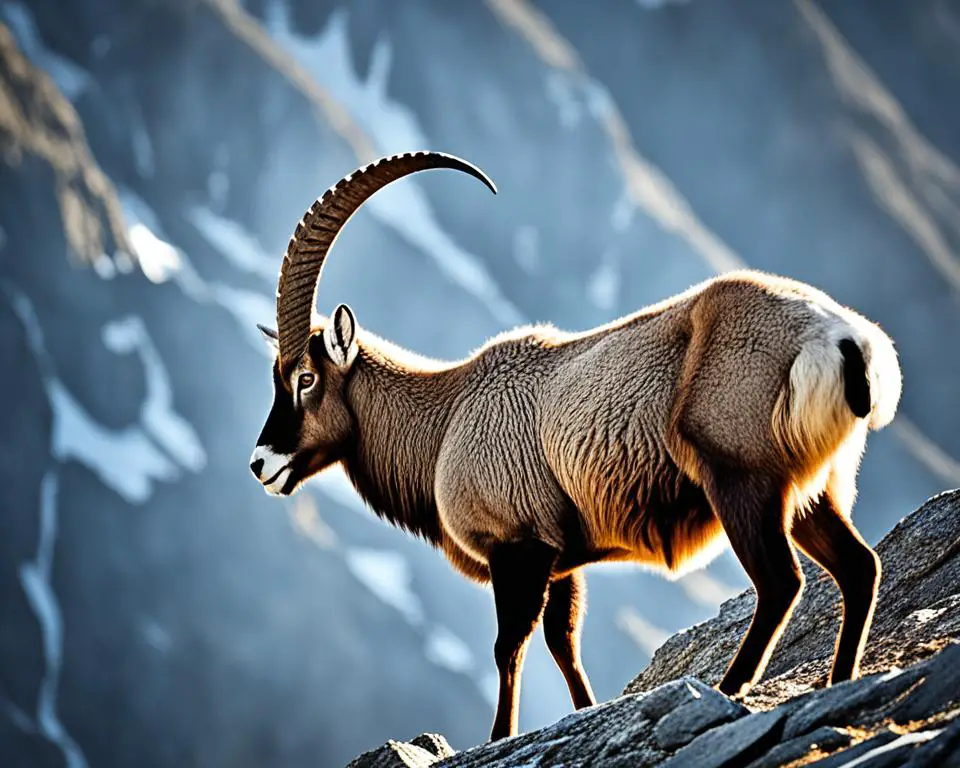
As you glimpse across the varied representations of the ibex in human culture, you might find yourself drawn to its larger-than-life persona, an attribute that has been both a gift and a curse—inspiring awe while also making it a target for hunters seeking trophies and mythical cures. However, the true magic of the ibex doesn’t reside in the realm of myth, but in its real-world ability to navigate the vertical labyrinths of mountainous terrains with unmatched grace and power.
In the modern era, the ibex continues to captivate with its poise and presence, a tangible connection to the myths of yore and a reminder of the countless stories and symbols that herald its existence. As you ascend the veritable slopes of understanding, take a moment to appreciate the ibex not just as a creature of legend, but as a living symbol of the wild and unfettered essence of nature.
The Alpine Ibex: History’s Medical Misunderstanding
You might find it fascinating that the majestic Alpine Ibex once teetered on the brink of historical extinction due to ancient medical myths. Throughout history, the demand for its magnificent horns, driven by the false belief that they could cure impotence, put this species in grave danger. In a similar vein, its blood was also sought after under the misconception that it could alleviate kidney stones. This relentless hunt driven by unscientific medicinal claims led to a drastic decline in the population of these noble creatures.
Thankfully, shifting perspectives and increased ecological awareness paved the way for conservation measures that turned the tide for the Alpine Ibex. After recognizing the detrimental effects of these misguided practices, efforts were made to protect and restore the ibex populations, leading to a gradual but appreciable increase in their numbers. It’s a testament to the resilience of the species and the power of informed conservation initiatives.
Let’s delve into some key facts about the Alpine Ibex, illustrating its journey from peril to preservation:
| Aspect | Historical Impact | Conservation Measures |
|---|---|---|
| Horn Harvesting | Driven nearly to extinction due to medicinal myths | Legal protection and anti-poaching laws implemented |
| Blood Myths | Targeted by hunters for its purported health benefits | Educational campaigns to dispel myths |
| Population Recovery | Dangerously low numbers in wild | Reintroduction in protected areas and monitoring of populations |
| Educational Outreach | Lack of awareness about true ibex value and role in ecosystems | Increased public knowledge through eco-tourism and media |
As you further explore the captivating world of the Alpine Ibex, remember that understanding and debunking the medical myths of yesteryear is crucial to safeguarding not just the Ibex, but all wildlife. Their story of endurance, shaped by our shifting perceptions and actions, continues to inspire conservationists and animal lovers alike. And now their populations are climbing the mountain slopes, much like their own nimble ascent, towards a brighter future.
Risk and Reproduction: The Mating Strategies of Ibexes
When you venture out to the rugged mountain terrains during the ibex breeding season, you’re standing witness to a dramatic display of ibex mating behavior. Amid this fierce animal competition, each male is driven by a natural impulse to ensure his genes are carried forward. Males, their horns rising like ceremonial swords, participate in ritualistic courtship displays and engage in combative showdowns that echo across the cliffs.
But not all is about brute force; some younger males have devised sneaky reproductive strategies. These tactics, while less dramatic, play a crucial role in diversifying the gene pool and survival of the species. As you observe, you might wonder how the drive to reproduce can evoke such a range of behaviors, from majestic battles to clandestine courtship. This is the essence of nature’s reproductive tapestry, woven with the threads of both risk and strategy.
Let’s delve deeper into the intricate reproductive strategies that characterize ibex society:
- Courtship: Males will perform visually striking displays, showcasing their physical fitness and attractive traits to woo females.
- Head-to-head Battles: Dominant males often engage in head clashes, displaying their strength and dominance to earn mating rights.
- Sneaker Strategy: Subordinate males, unable to compete head-on, may stealthily mate with females while dominant males are distracted.
- Genetic Diversity: These varied mating tactics ensure a mix of genetic material, enhancing herd resilience over generations.
| Mating Strategy | Risk Level | Benefits |
|---|---|---|
| Courtship Displays | Low to Medium | Attracts attention from females without direct confrontation. |
| Head-to-head Battles | High | Shows physical prowess; potential to secure multiple mates. |
| Sneaky Matings | Low | Allows less dominant males a chance to reproduce without battle injuries. |
| Genetic Variation | Community Level | Enriches genetic pool, supporting herd health and adaptability. |
Understanding the sophisticated nuances of reproductive strategies in ibexes gives us a glimpse into the intricacies of wildlife behaviors. The mating season, replete with grand gestural displays and sly tactics, reveals a complex world where survival and reproduction are intertwined with competition and risk. As these astonishing animals navigate the perils and passions of their existence, their tale of life continues to unfold in the rugged theatres of the mountains.
Coexistence Challenges: Ibex Hybrids in the Alps
In the grand scheme of alpine wildlife management, the natural world sometimes presents us with unexpected phenomena like ibex hybrids, a result of interspecies breeding. While Alpine Ibexes are icons of the European highlands, they face genetic hurdles that stem from limited genetic diversity in small populations. This problem has led to unintended crossbreeding with domestic goats, providing unique insights into the complexities of wildlife genetics in the Alps.
The Genetic Consequences of Interspecies Breeding
The creation of ibex-goat hybrids is a direct result of interspecies breeding, which can occur when ibexes come into contact with domestic goats in the Alpine regions. This mixing of species aims to overcome genetic bottlenecks but does not come without repercussions. The hybrids face a curious intersection of genetics, where questions arise about their vitality and biological fitness in the wild.
The genetic diversity these hybrids bring to the population could have potential benefits, such as introducing traits that may improve adaptability. However, reduced fertility rates among these hybrids are a significant concern, potentially dampening the success of natural ibex populations to thrive independently. It raises challenging questions about the long-term ecological impact and the conservation of pure ibex lineages.
Adaptation and Survival of Hybrids in Alpine Conditions
Adapting to the unique climate and landscape of the Alps is no small feat. For ibex hybrids, blending the hardy characteristics of domestic goats with the alpine adeptness of ibexes could manifest as a survival advantage or a complex challenge. Understanding their place in the ecosystem is critical, as their ability to thrive could alter the ecological balance in unforeseen ways.
With ongoing environmental change and human impacts on habitats, these hybrids’ influence on the ecosystem must be monitored to ensure that the overall biodiversity of the Alpine region remains robust and flourishing. Conservationists and researchers continue to assess the opportunity for these hybrids to contribute positively to genetic diversity while still preserving the distinctive traits that make ibex species so well-suited to their high-altitude homes.
| Aspect | Ibex Hybrids | Pure Ibex |
|---|---|---|
| Fertility | Generally reduced | Not affected |
| Adaptations | Potential for new traits | Specialized for alpine conditions |
| Conservation Concerns | Impact on pure ibex populations | Maintaining genetic purity |
| Suitability for Habitat | Under study | Fully adapted |
| Role in Ecosystem | Uncertain | Known and established |
The coexistence of ibex hybrids and pure ibex populations in the Alps presents an intriguing example of nature’s resilience, challenging humans to think critically about how we foster genetic diversity while honoring the natural genetic lineage of native species. As we continue to marvel at these creatures, may we tread thoughtfully in their high-elevation world, safeguarding the delicate balance they maintain in the face of shifting ecological dynamics.
Conclusion
In the journey of understanding ibexes, we’ve scaled the craggy peaks of their habitat, marveled at their dietary aptitude, and observed their intricate social structures and impressive reproductive strategies. These adaptive species offer profound insights into the resilience of wildlife in mountain ecosystems, and highlight the sheer brilliance of evolutionary adaptability. As we contemplate their future, it is evident that comprehensive ibex conservation efforts are essential in safeguarding their existence against the threats of habitat loss and climate change.
The challenges that ibex populations face are a clarion call for increased awareness and research, to continually adapt our conservation strategies to the changing landscapes influence by both nature and human activities. Your understanding and engagement are vital in these efforts, as is the dedication of wildlife conservationists and researchers who tirelessly work to protect these majestic creatures. Their survival is not just about preserving an iconic mountain dweller; it’s about respecting and conserving the rich biodiversity that these ibexes so eloquently represent.
In the end, your fascination and commitment to these creatures fuel the enduring mission to ensure ibexes continue to thrive. By supporting habitat preservation, advocating for ethical wildlife practices, and delighting in the unique traits of these mountainous monarchs, you contribute to a hopeful future where ibexes remain an enduring benchmark of nature’s splendor. As resilient navigators of their vertical world, ibexes inspire us to reach new heights in our efforts to understand and protect the diverse tapestry of life that ornaments our planet.

